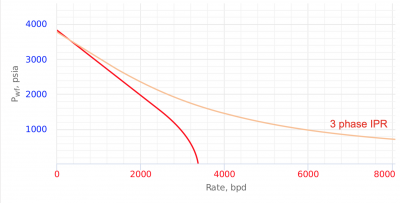Difference between revisions of "3 Phase IPR"
From wiki.pengtools.com
(→3 Phase IPR calculation example) |
(→3 Phase IPR calculation example) |
||
| Line 20: | Line 20: | ||
==[[3 Phase IPR]] calculation example== | ==[[3 Phase IPR]] calculation example== | ||
| − | |||
Following the well #1 example given by Brown<ref name=KermitBrown1984 />on Figure 5.8, page 191: | Following the well #1 example given by Brown<ref name=KermitBrown1984 />on Figure 5.8, page 191: | ||
Latest revision as of 07:51, 17 April 2019
Contents
Three-phase Inflow Performance Relationship

3 Phase IPR Curve [1]
3 Phase IPR is an IPR curve calculated on the basis of total barrels of produced fluid, including gas.
3 Phase IPR curve is used in Pump Design software for pump sizing.
Math and Physics
The volume of 1 stb of liquid plus associated gas at any pressure and temperature is given by[1]:
The total volume of produced fluid rate (liquid plus gas) at any conditions of pressure and temperature:
 is calculated as usual using:
is calculated as usual using:
- Vogel's IPR equation
- Composite IPR equation
3 Phase IPR calculation example
Following the well #1 example given by Brown[1]on Figure 5.8, page 191:
In progress ...
Nomenclature
 = volume factor, bbl/stb oil; bbl/scf gas
= volume factor, bbl/stb oil; bbl/scf gas = gas liquid ratio, scf / bbl
= gas liquid ratio, scf / bbl = flowing rate, stb/d
= flowing rate, stb/d  = solution gas ration, scf / stb
= solution gas ration, scf / stb = total volume of produced fluid rate (inducing gas), bbl/d
= total volume of produced fluid rate (inducing gas), bbl/d = volume factor, bbl/stb
= volume factor, bbl/stb = water cut, fraction
= water cut, fraction
Subscripts
- g = gas
- o = oil
- sc = standard conditions
- t = total
- w = water


